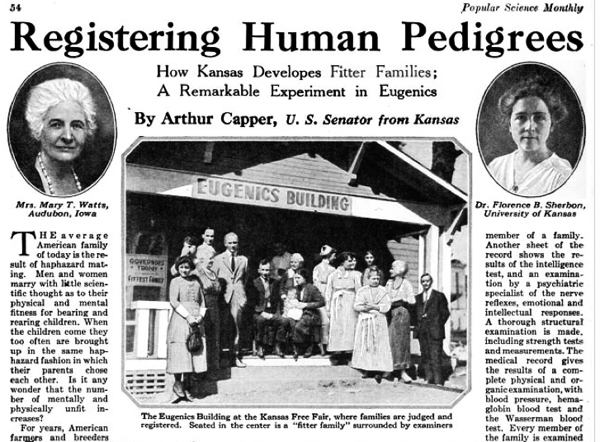At the beginning of the twentieth century, there was a boom in scientific knowledge and understanding that influenced virtually all aspects of American life. One area that was gaining popularity among the scientific community, doctors, and even politicians, was that of eugenics. Sir Francis Galton, a British scientist and cousin to Charles Darwin, came up with the idea of eugenics as a way to improve future generations of the human race by selecting desirable human traits and eliminating the undesirable traits.1 Though not a new concept–it has been found in Plato’s Republic (c. 378 BCE) and in Tommaso Campanella’s City of the Sun (1623)–it became popular in the United States when Mendelian genetics became more widely accepted by American scientists during the Progressive Era.2
Following World War I, the United States became a world power and many citizens feared that the large influx of immigrants would bring political and economic failure. Scientists began to convince doctors and politicians, who in turn convinced the American public, that the key to maintaining world peace was democracy, capitalism, and eugenics.3 It was believed that by controlling the reproduction of humans, some disabilities and illnesses could be eradicated. If scientists could remove mental illness as well as intellectual and physical disabilities from American society, then the United States could have a stronger human race, maintaining its dominance of the world stage.4 In an effort to make this happen, the Eugenics Record Office (ERO) opened in New York in 1910, funded largely by the Carnegie Foundation. The primary mission of the ERO was “to improve the natural, physical, mental, and temperamental qualities of the human family” through genetics.5
The ERO believed that certain groups had too much “feeble-mindedness,” and that eliminating that genetic trait would make Americans better people. “Feeble-minded” people included those who were mentally retarded, criminals, epileptics, alcoholics, diseased with tuberculosis, leprosy, syphilis, blind, deaf, deformed, poor, or simply a ne’er-do-well. The ERO also believed these traits to be more predominant in certain groups of people, especially southern and eastern Europeans and Asians.6 The ERO launched a public education campaign to inform people of the problems with “feeble-mindedness” with displays at the Chicago World’s Fair in 1933 and 1934 as well as fitter family and better baby contests at county and state fairs throughout the country. By the early 1930’s, public schools and colleges were educating students on eugenics through health and science classes. Advertising even got in on the eugenics bandwagon by promoting human breeding as being similar to breeding livestock and raising better crops and just as important to the success of America.7

In order to improve the human family, advocates of eugenics began to think that the best way to stop these illnesses was a twofold solution: stop the “undesirable” people from immigrating into the country, and stop the “feeble-minded” people already here from reproducing. The Immigration Act of 1924 was a result of the eugenics movement’s attempt to keep the “undesirables” from southern and eastern Europe from entering the country by using strict entrance quotas. It also banned Asian immigrants completely. (This act would not be changed until the 1960’s.) Next, the eugenics movement began to encourage states to pass laws that allowed compulsory sterilization of anyone that received any type of public assistance, especially those in mental institutions. Thirty-two states acted quickly to pass such laws that called for mandatory sterilization of anyone deemed “feeble-minded” by the state, including some children as young as nine years old.8

The Supreme Court became involved in the eugenics movement in 1927 when it ruled on the case of Buck v. Bell. Carrie Buck was a poor, young adult with slightly below average intelligence that had been institutionalized when she accused a rich boy of raping her and causing her to have a child out-of-wedlock. The institution decided she was “feeble-minded,” and since she was fertile, she therefore needed to be sterilized. Carrie refused to agree to being sterilized and the case was finally brought to the Supreme Court, which ruled 8-1 in favor of allowing forced sterilization for eugenic purposes only. Justice Oliver Wendall Holmes wrote the majority opinion: “It is far better for the world, if instead of waiting to execute degenerate offspring for a crime, or to let them starve for their imbecility, society can prevent those who are manifestly unfit from continuing their kind.”9 He added specifically about Carrie Buck that “three generations of imbeciles are enough.”10

The eugenics movement reached its height of popularity in America in the mid- to late-1930’s. City governments embraced the concept of eugenics because it blamed the problems of inner cities, crime, and poverty, on the humans and not on the inadequate living conditions forced upon the human poor.11 Prisons, psychiatric hospitals, and care institutions reported that many of their inhabitants were repeat offenders with many of their patients being related to one another. As a result, the institutions supported eugenics because it would reduce their operating costs by lowering the number of people needing services once all the “feeble-minded” were sterilized.12 At no time did anyone stop to consider that many of the diseases and illnesses that eugenics hoped to eradicate were not genetic, but instead were caused by environmental factors.13 During this time period, almost 70,000 Americans were forcibly sterilized.14
Meanwhile, in Europe, “Nazi Germany adopted American measures to identify and selectively reduce the presence of those deemed to be ‘socially inferior’ through involuntary sterilization.”15 It did not take long for the Nazis to extend their eugenics movement to include the elimination of Jewish and other non-Aryan populations. Only at this time did many people in America begin to rethink their stance on eugenics, with many politicians, scientists, and doctors denouncing the ERO. The ERO was officially closed in 1939 when the Carnegie Foundation pulled their funding, bringing the eugenics movement in the United States to an unofficial end.16
However, forced sterilization still continued in the United States, especially through the California prison system and in the southern states where poor southerners were often sterilized as a means to end poverty. These practices began to taper off in the 1970’s as people became more aware of human rights and equality.17 Yet it was not until the 1978 Federal Sterilization Regulations were created to prevent the forced sterilizations performed in the country that most of these practices ended.18 Even so, Buck v Bell has never been overturned and was cited most recently as precedent in the case of Vaughn v Utz, which was heard before the US Court of Appeals, 8th Circuit in 2001.19
While the eugenics movement can be considered a darker part of American history, several good things have resulted from this time. During the Nuremberg trials, the defense cited the case of Buck v Bell in support of the sterilizations they performed on people.20 Judges at these trials decided there was a need for oversight of all experiments done on human test subjects and the Nuremberg Code of 1947 was written to provide such guidelines, which are still used today.21 After this time, many of the labs devoted to the pseudoscience of eugenics changed the focus of their research to ethical genetic advancements and have made many of the genetic discoveries we now have.22 Lastly, in the effort of the eugenics movement to create fitter families, many states adopted incest laws for the first time during the 1920’s and 1930’s.23
- Encyclopedia Britannica, January 2017, s.v. “Eugenics,” by Philip K. Wilson. ↵
- Encyclopedia Britannica, January 2017, s.v. “Eugenics,” by Philip K. Wilson; Karen Norrgard, “Human Testing, the Eugenics Movement, and IRBs,” Nature Education 1, no. 1 (2008): 170. ↵
- Encyclopedia Britannica, January 2017, s.v. “Eugenics,” by Philip K. Wilson. ↵
- Karen Norrgard, “Human Testing, the Eugenics Movement, and IRBs,” Nature Education 1, no. 1 (2008): 170. ↵
- Karen Norrgard, “Human Testing, the Eugenics Movement, and IRBs,” Nature Education 1, no. 1 (2008): 170. ↵
- Encyclopedia Britannica, January 2017, s.v. “Eugenics,” by Philip K. Wilson. ↵
- Encyclopedia Britannica, January 2017, s.v. “Eugenics,” by Philip K. Wilson. ↵
- Karen Norrgard, “Human Testing, the Eugenics Movement, and IRBs,” Nature Education 1, no. 1 (2008): 170. ↵
- Andrea DenHoed, “The Forgotten Lessons of the American Eugenics Movement,” The New Yorker, April 27, 2016. ↵
- Andrea DenHoed, “The Forgotten Lessons of the American Eugenics Movement,” The New Yorker, April 27, 2016. ↵
- Karen Norrgard, “Human Testing, the Eugenics Movement, and IRBs,” Nature Education 1, no. 1 (2008): 170. ↵
- Karen Norrgard, “Human Testing, the Eugenics Movement, and IRBs,” Nature Education 1, no. 1 (2008): 170. ↵
- Karen Norrgard, “Human Testing, the Eugenics Movement, and IRBs,” Nature Education 1, no. 1 (2008): 170. ↵
- Andrea DenHoed, “The Forgotten Lessons of the American Eugenics Movement,” The New Yorker, April 27, 2016. ↵
- Encyclopedia Britannica, January 2017, s.v.”Eugenics,” by Philip K. Wilson. ↵
- Encyclopedia Britannica, January 2017, s.v. “Eugenics,” by Philip K. Wilson. ↵
- Andrea DenHoed, “The Forgotten Lessons of the American Eugenics Movement,” The New Yorker, April 27, 2016. ↵
- Encyclopedia Britannica, January 2017, s.v. “Eugenics,” by Philip K. Wilson. ↵
- Andrea DenHoed, “The Forgotten Lessons of the American Eugenics Movement,” The New Yorker, April 27, 2016. ↵
- Andrea DenHoed, “The Forgotten Lessons of the American Eugenics Movement,” The New Yorker, April 27, 2016. ↵
- Karen Norrgard, “Human Testing, the Eugenics Movement, and IRBs,” Nature Education 1, no. 1 (2008): 170. ↵
- Encyclopedia Britannica, January 2017, s.v. “Eugenics,” by Philip K. Wilson. ↵
- Karen Norrgard, “Human Testing, the Eugenics Movement, and IRBs,” Nature Education 1, no. 1 (2008): 170. ↵



19 comments
Samire Adam
This article completely caught my attention while reading. I never knew that the United States ever participated in eugenics. Eugenics is a concept that I wish will ever come to light, especially in America, which is supposed to be a melting pot. Eugenics should have never been promoted in in America because diversity is the what makes this country to great. Thank you for writing this article.
Natalie Juarez
Nazi Germany was the only time I ever heard about Eugenics before. Reading about it taking place in Americas made me uneasy, but I am glad there is an article for me to learn about it because I most likely would have never came across the information anywhere else without trying to look for it. The man who came up with the idea of Eugenics, Francis Galton, may have brought light to the practice in a negative and inhumane way “to improve future generations,” but it is comforting to know that todays research has been done and eugenics has changed to focus on “ethical genetic advancements.” This was a great article to read!
Cynthia Rodriguez
I think the whole idea of eugenics is crazy. How could one actually want to control reproduction? I cannot believe that scientists thought that one factor that would contribute to maintaining world peace is eugenics. It is just shocking to me that they actually recommended human breeding. It was also shocking to read that 32 states passed mandatory sterilization laws. I thought this was an engaging article. Great read!
Arieana Martinez
The practice of eugenics is something that I thought only Germany participated in. This is a completely discriminatory practice that creates severe mental damage, because the traits are being manipulated too much and the results are not always the perfect scenario that is originally imagined. The Nazi regime truly spread to other countries, which is unfortunately something we are still trying to move on from today.
Jabnel Ibarra
Eugenics is the sort of ideology you’d think you would only find in novels about dystopian societies. To think that it was once a part of American history is a grim reminder of how far we’ve come. I had no idea that American eugenics were a key inspiration for Nazi ideology, or how widely eugenics was accepted in the United States.
Engelbert Madrid
Eugenics is a scientific concept that I heard of before; however, I didn’t know a lot about it and why it was a big deal in the world. I’m glad I read this article, because it gave me a clear understanding of what eugenics means and what roles did this concept play in American politics and society. It is interesting to know that most Americans, especially politics, blamed the living nature of the working class by using eugenics as a “reasonable” concept of why some people are not successful as others.
Gabriela Murillo Diaz
Eugenics is such an interesting controversial topic and I never would have known this information without the background provided by this article. For such a controversial topic, it was well written and taught me a lot about eugenics. It is something that isn’t discussed much and I believe it is important we pay more attention to it. The discussion of the cases was very important to truly understand the context of eugenics in the United States.
Natalie Childs
This was a really well done article. Before reading, I actually knew a decent amount about eugenics, as well as the support that it garnered in the early 20th century. It is absolutely staggering that 70,000 Americans were forcibly sterilized during that time period for a whole slew of reasons, some of which had to do with the environment that they lived in. Furthermore, the fact the Buck v Bell still hasn’t been overturned, and has been cited as recently as 2001, is just mind boggling.
Cameron Ramirez
I would have never believed that the United States in the early 20th century promoted eugenics. Not only that but that laws set in place during this time forcefully sterilized over 64,000 people. Your article goes into very great detail where it all started from and how it moved into the United States and was forced upon the American people. It is so sad that this is something the United States must live within its history. Overall, good work and interesting topic!
Brianda Gomez
The Unites States was seeing a lot of mental illnesses and physical disabilities. The united states wanted a strong human race to keep dominating. It was during this time that the eugenics movement was a dark part of history. The Nuremberg trials consisted of heartless doctors experimenting on victims without their consent. As a result the Nuremberg code of 1947 was rules that scientists now had to follow for experimentation on human subjects. Great article!